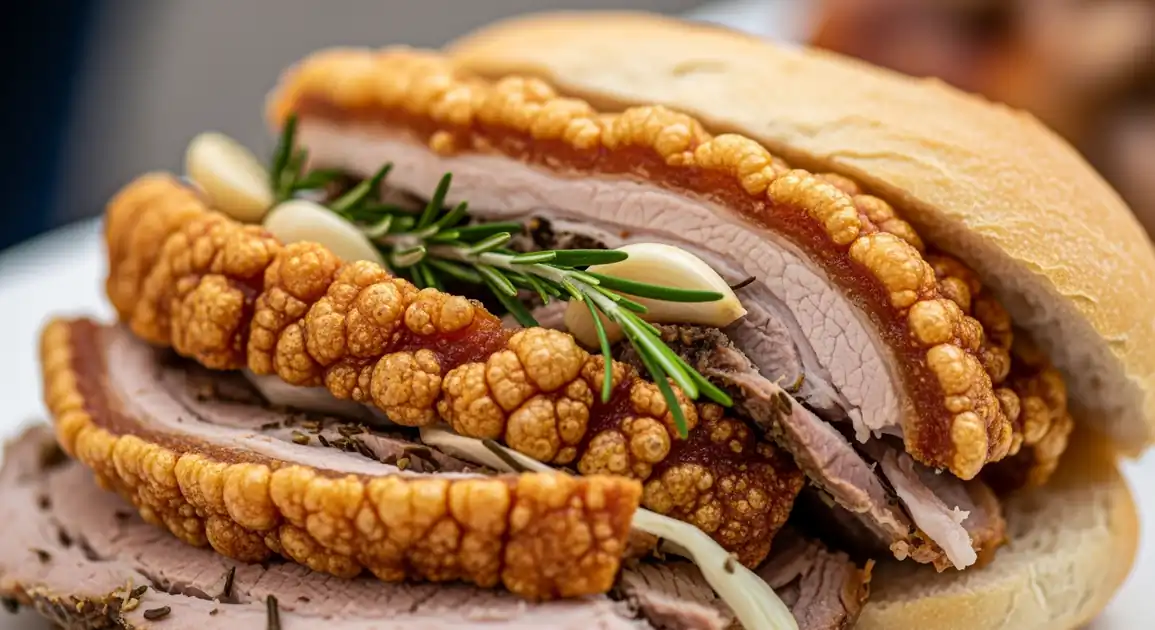Porchetta
Porchetta

Description
Porchetta is a beloved specialty throughout Central Italy (Lazio, Umbria, Tuscany, Marche, Abruzzo), but its popularity has spread across the country. It's primarily enjoyed as street food from dedicated vans or market stalls, especially during festivals, market days, and as a lunchtime panino. Quality and seasoning styles can vary significantly by region and vendor.
Dietary Information
Serving information
Serving style
Most commonly served sliced in a crusty bread roll ('panino'). Also sold sliced by weight ('al taglio', measured in 'etti' - 100 grams) from markets or norcinerie, often wrapped in paper.
Quick facts
Street vendors often operate from mid-morning (e.g., 10 AM) through lunch until they sell out (mid-afternoon). Market vendors follow market hours.
Safety Tips
What to Look For
-
Vendor slices meat fresh from the whole roast
Ensures freshness and avoids risks associated with pre-sliced meat sitting out.
-
Meat appears moist and skin looks crispy
Visual cues for quality and proper cooking/holding. Avoid porchetta that looks dry or has soggy skin.
-
Clean vendor setup (truck/stall, knives, board)
Good hygiene practices are essential for food safety.
-
High customer turnover
Indicates the porchetta is fresh and popular, reducing the time it sits around.
-
Porchetta kept warm (if applicable)
While often served room temp shortly after slicing, if it's meant to be hot, ensure it's held properly.
What to avoid
-
Pre-sliced porchetta sitting out for long periods
Increases risk of bacterial growth and loss of quality (dry meat, soggy skin).
-
Meat looks visibly dry, grey, or discolored
Suggests poor quality, overcooking, or being old.
-
Soggy, pale, or leathery skin
Indicates improper roasting or storage.
-
Dirty vendor area, knife, or cutting board
High risk of cross-contamination.
-
Unpleasant or 'off' smell
Indicates spoilage; do not consume.
Price information
Price range
Budget tips
- Prices are usually per panino (sandwich) or per 100g ('etto') if bought sliced.
- Street vendors and market stalls offer the best value.
- Prices can be slightly higher in major tourist centers.
Value indicators
- Generous amount of meat in the panino.
- Perfectly crispy skin ('crosta croccante').
- Moist, well-seasoned meat.
- Freshly sliced from a whole roast.
- Vendor reputation (often local knowledge is key).
Where to Find This Dish
Central Italy
The heartland of porchetta (Lazio, Umbria, Tuscany, Marche, Abruzzo).
Ariccia (Lazio), Norcia (Umbria), Local markets, Roadside stalls
Lunch, Market days
Weekly Markets ('Mercati Settimanali')
Many towns have weekly markets where porchetta vendors are a common sight.
Town piazzas on market day
Morning (market hours)
Festivals ('Sagre')
Food festivals dedicated to porchetta or local products often feature multiple vendors.
Various towns, check local event listings
Festival hours
Vendor Tips
- Follow the crowds – popular vendors usually have the best product.
- Don't be afraid to ask for a sample of the skin if unsure.
- Specify if you prefer leaner or fattier slices, or more skin.
- Have cash ready, especially for street vendors.
How to Order
Regional Variations
-
Porchetta di Ariccia IGP
(Porchetta di Ariccia IGP)
Protected designation from Ariccia (near Rome), known for specific seasoning (often rosemary, garlic, pepper) and meticulous preparation.
-
Tuscan Style Porchetta
(Porchetta Toscana)
Often seasoned more heavily with rosemary and garlic compared to the wild fennel sometimes favored further south.
-
Umbrian Style Porchetta
(Porchetta Umbra)
May include chopped entrails like liver in the stuffing for a richer, deeper flavor.
-
Porchetta 'Tronchetto'
(Tronchetto di Porchetta)
A smaller version made not from a whole pig but typically from the loin and belly section, rolled and roasted.
Cultural context
History
Porchetta boasts ancient origins, potentially dating back to Etruscan or Roman times in Central Italy. Its modern form is strongly associated with regions like Lazio (particularly the town of Ariccia, which holds IGP status for its specific recipe), Umbria, Tuscany, and Abruzzo. Historically a festive dish prepared for celebrations and holidays, porchetta became popular street food sold from mobile vans and market stalls, especially in the post-war era, providing affordable, flavorful sustenance. Today, it remains a beloved staple across Italy, with regional variations in seasoning.
Local significance
A symbol of Italian street food culture and regional culinary traditions. Represents conviviality, festivals, and simple, delicious food.
Eating customs
- Eating the panino standing up near the vendor truck/stall is typical.
- Often enjoyed with a simple glass of local wine or beer.
- Appreciating the contrast between the crispy skin and tender meat.